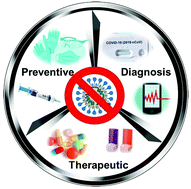Essential role of quantum science and nanoscience in antiviral strategies for COVID-19
Abstract
The severe acute respiratory syndrome coronavirus (SARS-CoV-2) that caused the COVID-19 disease pandemic since December 2019 highlights the importance of developing efficient antiviral strategies to prevent and treat viral infection. Virus particles are nanosized, therefore design strategies are suitable to develop advanced nano and quantum materials that can interact with and mimic virus particles. Quantum science and nanoscience can help in the synthesis and functionalization of nanomaterials for virus prevention, treatment, and detection. The first step is identifying the genome sequencing of the virus, then the fabrication of antiviral (virustatic or virucidal) materials. Quantum and nanoscience-enabled nanomaterials yield better performance and flexibility for virus detection, vaccine design and delivery, facemasks, respirators, and drugs. In this review, we explore the applications of quantum and nanoscience in diagnosis, inhibition, and antiviral therapy. Further, we explain how the van der Waals forces, electrostatic interactions, fluctuation of the medium, electrodynamic and thermal fluctuations, local field enhancement effect, and reactive oxygen species (ROS) generation can prevent the viral life cycle through the virustatic and virucidal effects of quantum and nanoparticles.



 Please wait while we load your content...
Please wait while we load your content...